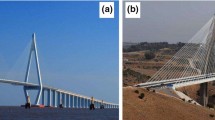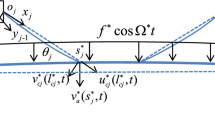Abstract
The nonlinear dynamic model of a shallow arch with multiple cables is developed to model a long-span cable-stayed bridge. Based on the veering phenomenon of cable-stayed bridges, the in-plane modal internal resonance between the first mode of the shallow arch and the first mode of the cable is investigated under both primary resonance and subharmonic resonance. Modulation equations of the dynamic system are obtained by Galerkin discretization and the multiple scales method, in which the equilibrium solution of modulation equations is obtained by the Newton–Raphson method. Meanwhile, the Runge–Kutta method is applied to directly solve the ordinary differential equations to verify the accuracy of the perturbation analysis. Numerical analysis shows that the internal resonance occurs in adjacent cables; the energy transfer mechanism and the dynamic behavior of system become more complex.












Similar content being viewed by others
Data availability
All data generated or analyzed during this study are included in this published article.
References
Sun, C., Zhao, Y., Peng, J., et al.: Multiple internal resonances and modal interaction processes of a cable stayed bridge physical model subjected to an invariant single-excitation. Eng. Struct. 172, 938–955 (2018)
Irvine, H.M.: Cable Structures. The MIT Press, Cambridge (1981)
Luongo, A., Rega, G., Vestroni, F.: Non-linear free vibrations of an elastic cable. Int. J. Nonlinear Mech. 19, 39–52 (1984)
Hagedorn, P., SchFer, B.: On non-linear free vibrations of an elastic cable. Int. J. Nonlinear Mech. 15, 333–340 (1980)
Perkins, N.C.: Modal interactions in the non-linear response of elastic cables under parametric/external excitation. Int. J. Nonlinear Mech. 27, 233–250 (1992)
Zhao, Y., Wang, L.: On the symmetric modal interaction of the suspended cable: three-to-one internal resonance. J. Sound Vib. 294, 1073–1093 (2006)
Guo, T., Kang, H., Wang, L., et al.: Cable dynamics under non-ideal support excitations: nonlinear dynamic interactions and asymptotic modelling. J. Sound Vib. 384, 253–272 (2016)
Abou-Rayan, A.M., Nayfeh, A.H., Mook, D.T., et al.: Nonlinear response of a parametrically excited buckled beam. Nonlinear Dyn. 4, 499–525 (1993)
Abhyankar, N.S., Hall, E.K., Hanagud, S.V.: Chaotic vibrations of beams: numerical solution of partial differential equations. J. Appl. Mech. 60, 167–174 (1993)
Blair, K.B., Krousgrill, C.M., Farris, T.N.: Nonlinear dynamic response of shallow arches to harmonic forcing. J. Sound Vib. 194, 353–367 (1992)
Lacarbonara, W.: Theoretical and experimental investigation of nonlinear vibrations of buckled beams. Virginia Polytechnic and State University, Blacksburg (1997). Ph.D Thesis
Zhao, Y., Peng, J., Zhao, Y., et al.: Effects of temperature variations on nonlinear planar free and forced oscillations at primary resonances of suspended cables. Nonlinear Dyn. 89, 2815–2827 (2017)
Gattulli, V., Morandini, M., Paolone, A.: A parametric analytical model for non-linear dynamics in cable-stayed beam. Earthq. Eng. Struct. Dyn. 31, 1281–1300 (2010)
Fujino, Y., Warnitchai, P., Pacheco, B.M.: Experimental and analytical study of autoparametric resonance in a 3DOF model of cable-stayed-beam. Nonlinear Dyn. 4, 111–138 (1993)
Wei, M., Xiao, Y., Liu, H.: Bifurcation and chaos of a cable–beam coupled system under simultaneous internal and external resonances. Nonlinear Dyn. 67, 1969–1984 (2012)
Wei, M., Xiao, Y., Liu, H., et al.: Nonlinear responses of a cable-beam coupled system under parametric and external excitations. Arch. Appl. Mech. 84, 173–185 (2014)
Cong, Y., Kang, H., Guo, T., et al.: One-to-one internal resonance of a cable-beam structure subjected to a concentrated load. J. Sound Vib. 529, 116915 (2022)
Kang, H., Guo, T., Zhao, Y., et al.: Dynamic modeling and in-plane 1:1:1 internal resonance analysis of cable-stayed bridge. Eur. J. Mech. A Solids 62, 94–109 (2017)
Kang, H., Guo, T., Zhu, W.: Analysis On the in-plane 2:2:1 internal resonance of a complex cable-stayed bridge system under external harmonic excitation. J. Comput. Nonlinear Dyn. 16, 101001 (2021)
Han, H., Liu, L., Cao, D.: Forced vibration of a cable-stayed beam by Green’s function approach. Int. J. Struct. Stab. Dyn. 20, 2050055 (2020)
Wang, Z.: Modelling with Lagrange’s method and experimental analysis in cable-stayed beam. Int. J. Mech. Sci. 176, 105518 (2020)
Jalali, M.H., Rideout, G.: Three-dimensional dynamic modelling and validation for vibration of a beam-cable system. Math. Comput. Model. Dyn. Syst. 27, 87–116 (2021)
Gattulli, V., Lepidi, M.: Localization and veering in the dynamics of cable-stayed bridges. Comput. Struct. 85, 1661–1678 (2007)
Caetano, E., Cunha, A., Gattulli, V., et al.: Cable-deck dynamic interactions at the international Guadiana Bridge: on-site measurements and finite element modelling. Struct. Control. Health Monit. 15, 237–264 (2010)
Kandil, A.: Internal resonances among the first three modes of a hinged-hinged beam with cubic and quintic nonlinearities. Int. J. Nonlinear Mech. 127, 103592 (2020)
Nayfeh, A.H., Mook, D.T.: Nonlinear Oscillations. Wiley, New York (1981)
Yi, Z., Wang, L., Kang, H., et al.: Modal interaction activations and nonlinear dynamic response of shallow arch with both ends vertically elastically constrained for two-to-one internal resonance. J. Sound Vib. 333, 5511–5524 (2014)
Turmo, J., Luco, J.E.: Effect of hanger flexibility on dynamic response of suspension bridges. J. Eng. Mech. 136, 1444–1459 (2010)
Nayfeh, A.H., Raouf, R.A.: Non-linear oscillation of circular cylindrical shells. Int. J. Solids Struct. 23, 1625–1638 (1987)
Funding
This study is supported by the National Natural Science Foundation of China (11972151, 11872176 and 12202109).
Author information
Authors and Affiliations
Corresponding author
Ethics declarations
Conflict of interest
The authors declare that they have no conflict of interest.
Additional information
Publisher's Note
Springer Nature remains neutral with regard to jurisdictional claims in published maps and institutional affiliations.
Appendices
Appendix A
Appendix B
Rights and permissions
Springer Nature or its licensor (e.g. a society or other partner) holds exclusive rights to this article under a publishing agreement with the author(s) or other rightsholder(s); author self-archiving of the accepted manuscript version of this article is solely governed by the terms of such publishing agreement and applicable law.
About this article
Cite this article
Kang, H., Cai, Y., Cong, Y. et al. Resonance analysis between deck and cables in cable-stayed bridges with coupling effect of adjacent cables considered. Nonlinear Dyn 111, 6295–6316 (2023). https://doi.org/10.1007/s11071-022-08180-1
Received:
Accepted:
Published:
Issue Date:
DOI: https://doi.org/10.1007/s11071-022-08180-1




